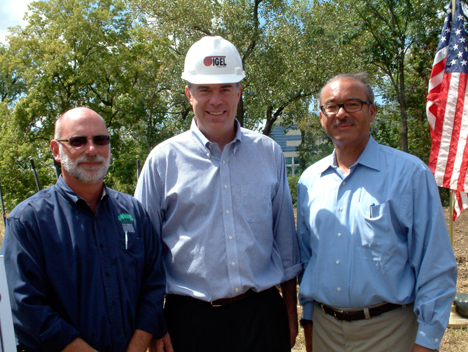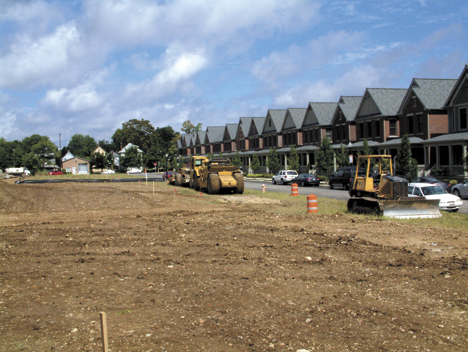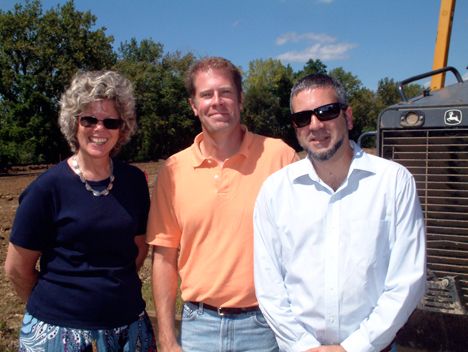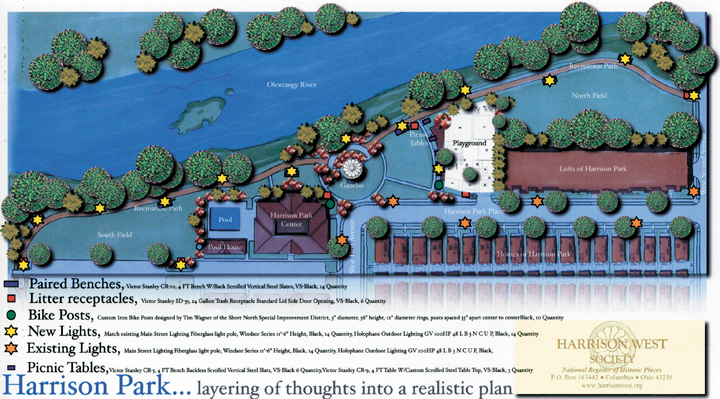
Columbus, Ohio USA
Return to Homepage www.shortnorth.com
Harrison Park: An Urban Gem
Developer Gambles on Community's Dream Park,
and Wins
By Cindy Bent Findlay
October 2010 Issue
Return to Homepage
Return to Features Index
Return to Neighborhood OrganizationsPhotos © Gus Brunsman III
Mark Wagenbrenner (center), whose company donated property for the park in Harrison West, with Alan McKnight (left) of Columbus Recreation and Parks, and Mayor Coleman at the groundbreaking on September 3, 2010. Sure, right now, it looks like a patch of dirt. And sure, Harrison West, you’ve been waiting for your park for a long time – since 2003.
But it will be worth it. On September 3, the city, the community, and the developers of the Harrison Park development were on hand to break ground for the newest jewel in the Short North, the future Harrison Park.
In the end, the record will show that unprecedented community, private and governmental cooperation led to both long delays in the park’s inception, and to the creation of a green gathering place that will better serve the neighborhood because of the teamwork that went into it.
Once upon a time, Harrison Park was home to a run-down, empty and famously stinky factory. This autumn a playground, a gazebo, an amphitheatre and ballfields will emerge from the torn up sod. Harrison Park will line the east bank of the Olentangy River, extending to Harrison Park Place to the east, and stretching north and south between Quality Place and W. 2nd Avenue. A new lane for the Olentangy Trail will traverse the park; commissioned art by Columbus College of Art and Design students will grace its lawns.
Harrison Park will be an urban gem, planned so that each visitor’s experience of the park is carefully considered, from kids clambering over the public artwork to concertgoers enjoying music in the park, to brides and grooms being wed in the gazebo.
“It’s been a long journey but we’re almost there. It’s very exciting,” says Bob Mangia, chair of the Harrison West Society committee that has helped shepherd the park into being.
Part of the reason for the park’s long gestation was actually the somewhat novel funding mechanism that made it possible. Harrison Park is in part a gift from the Wagenbrenner Company, the developer who created the new Harrison Park development from which the park is carved.
Harrison Park (the development) is a community of single-family and condominium homes built on the site of the former A.C. Humko margarine factory. In the initial stages of that development, the Harrison West community banded together and demanded a seat at the planning table. Near the top of the neighborhood’s wish list: a park on the river.
“For years, we’ve had empty fields but never a park. With loss of Gowdy Field in the ’30s, the city always said it would replace those fields, and the voice of the people got lost over the years. I think we’ve finally found our voice again,” Mangia says.
Mangia, manager of the North Market shop Market Blooms, first became active in the community during the planning of Side by Side Park, a small green space that almost wasn’t until the Harrison West Society spoke up.
The Harrison West Society’s request was backed up by the city, which mandates through its Parkland Dedication ordinance that new developers who want a change to an area’s zoning must create green space.
The Wagenbrenner Company listened to Harrison West and agreed, donating almost three acres of the 16-acre parcel to a park.
What wasn’t mandated, though, was the unprecedented cooperation between the developer and the community and city. For once, say all involved, the logic of creating a win-win situation for everyone was clearly understood and even celebrated.
“We came to the conclusion that for our project to be successful, instead of thinking we knew what was best, we realized a lot of the people representing the community were similar to those we’d be selling to eventually. If they wanted [a park], there was a good chance future buyers would too,” says Mark Wagenbrenner, president of the Wagenbrenner Company.
The company donated three acres of land and also fronted the cost to establish the tax increment financing (TIF) mechanism. The TIF diverts tax revenue from increasing area real estate values for a ten year period of time to pay for the park. Bonds were sold on the proceeds of the tax increases. Taxes to the school district were still paid in full as only the non-school portion of revenue diverted.
Currently under construction, the park offers an expansive view for homeowners in the Harrison Park development. Wagenbrenner surrendered further home construction in favor of the park. The value of the land is hard to quantify, but Wagenbrenner estimates the company could have built 150 units there, units which also would have had a premium value with water views.
“But we said, if it was that dense, maybe the project would not be as well received. We have always supported the city’s riverfront vision. If you look at the cities that have kept that vision, it makes everything more valuable when communities have access to great public spaces. It makes for better neighborhoods. It’s hard to argue with places like Chicago where they are so good about keeping river access,” Wagenbrenner says.
Finances, not planning, were the primary reasons for the delay in the park’s groundbreaking. First, Wagenbrenner says, it took two to three years for property values to appreciate enough to support a revenue flow that could then be bonded.
Then, the actual body which the county wanted to issue the bonds, the Columbus-Franklin County Finance Authority, was a new player still in the middle of its own creation in 2006, through the early parts of the project.
Additional land, about two acres where Don Compton’s Roofing & Siding warehouse and office stood, was also purchased, which took time. Finally, industrial waste throughout the project had to be remediated to the satisfaction of the state.
“This is one of those times when patience pays off,” Wagenbrenner says. “We were fortunate that the income in the TIF built even higher, so when it all came it allowed us to do a park that’s a lot more evolved planning-wise, and to put all of it into place at once instead of in multiple phases.”
In the end, however, the park is truly funded by the Harrison West neighborhood, because the TIF’s funds are generated strictly by their property taxes.
Throughout six long years, what seems sometimes like the entire Harrison West neighborhood stayed tenaciously involved, years during which actual groundbreaking seemed impossibly far off.
“We had our first meeting in December of 2004. We met every month up until last year, and then every two months. In all we had more than 70 meetings. It’s very rare that a park is designed so much by the community, the vast majority is designed in house,” says Rob Harris, Harrison West Society president.
Harris, an architect who now works for the Wagenbrenner Company, says vetting the park thoroughly with the community was important, no matter how long it took.
“We’d research each topic, from the name of the park to the playground’s design. Then we’d go to the Society’s public forum, get their feedback, then decide, then go to the city for approval, but it was well worth it. You could maybe do things faster but that would not allow some people to participate,” says Harris.
“The city worked very hard to cooperate through the process as well. It was a different thing for them – they said it’s just a different ballgame. But we found it works,” Harris says.
“This is a very unique situation because the community is really the driving force in that the funding is coming through them. Something we really strive to do always is involve the community, we’d rather it be their park, it just works better when they’re involved,” says Maureen Lorenz, the landscape architect for the City of Columbus’s Recreation and Parks Department who was the primary public liason for the project.
“Also, the developer took a gamble on this area, they were responsible and had to recondition the area to make it habitable, and obviously it’s in their best interests to have a park as a central focus, it’s a real community builder,” says Lorenz.
In fact, a common misconception is that the park takes its name from the new development, when actually the reverse is true.
“What is unique is the developer having a vested interest and a caring interest. They wanted to see the best park they could. They gave up meeting space, his time and his staff’s time, there is a lot of involvement. A lot of the design work was pro bono. Even right now, they’re overseeing the development of the park,” Lorenz says.
The park’s face, though, is shaped from the reams of community input distilled through the park committee’s work. The committee itself was a team of twelve, and included Lorenz, Harris, Wagenbrenner, Mangia, and other members of the Harrison West Society.
Deep thought went into every feature, starting with the solid wrought-iron gazebo that marks the northern entrance.
“If you drive by and see an open field, you’re not going to assume it’s a park. But a gazebo, nothing stands more for public use. “We can use that,” it says. It will pull people down High Street, they’ll see it at the end of First Avenue, and walk to it. Once you get up there, you’re at the highest point, you can take the bike path to the left and the right and see the riverbank,” Harris says.
The city noted that Harrison West was in effect asking to be host to countless weddings, as brides seem to be attracted to gazebos like moths to a flame.
“We thought, cool! How neat to have weddings on what used to be a brownfield, a contaminated site. We want to have it used for music, too, and have bands here,” Harris says.
Maureen Lorenz, Recreation and Parks landscape architect with Matthew Williams (center) and Bob Mangia of the Harrison West Society. Mangia says that the committee researched century-old gazebos and found they were often wrought-iron and black rather than the white most people imagine. Since 2010 marks the 100th anniversary of the Recreation and Parks Department, and since the design fit with the character of the surrounding Italienate neighborhood, a historic design seemed only fitting. Harris created a copper-roofed, black iron gazebo, elegant and strong enough for the ages, that is currently being fabricated locally.
Public artwork will be designed by local students and voted on by the community at large. Four statues will eventually stand throughout the park. Community College of Art and Design students were invited to compete on designs for two large statues, and winners were selected at community meetings in February of 2009.
The first two echo the park’s ability to tie the city with nature. Riparian, a freeform aluminum figure, symbolizes the union
between the built environment and nature, and was designed by Amanda Vandenberg.
Mallory McClellan designed the second, Sycamore, a metal rendering of a fallen Sycamore tree. The statues should be installed late this fall. Prize money – $1500 for each winner – was funded through community fundraisers at Katalina’s Café Corner. Two more winners will be selected in another CCAD contest to begin this year, and Katalina’s is hosting another fundraising, a carnival, October 2.
Even the toys on the playground were painstakingly researched. Park committee member Elizabeth Cook visited playgrounds all over the city, says Harris.
“One thing she found, with the rocking horses, say, is if they’re cars or motorcycles, they’re not really used, but if they’re seahorses or dragonflies, the kids are all over them,” Harris says. “She put hours of time into all of the equipment.”
The total cost of park is now $1,320,000 – under budget, according to Harris. The price tag, in hours and dollars, should be well worth it to the neighbors, the city at large, and Wagenbrenner Development.
All 62 single-family homes in the development sold more quickly than expected, Wagenbrenner says, as have 100 of the 138 condominium units.
Though the economy is making it impossible to forge ahead with future planned phases now, Wagenbrenner say he’s been “in awe” of how property values have appreciated during the recession. It is true that the park was only one portion of the development’s story and its appeal, but, says Wagenbrenner, the park has surely played a role in both the development’s success and its acceptance in the neighborhood.
“If anything, though, I think we’ve undersold the park. Given the delays, it would have been very challenging to explain to people that bought homes here understanding that the park was coming if the process wasn’t so transparent. The committee worked really hard to keep everyone abreast of what was happening and why it was important,” Wagenbrenner says.
The company has even moved its office to the new development. “It’s all turned out better than we could have ever have expected,” Wagenbrenner says.
“One of the things I’ve been pleased with is even though the park could seem to appear part of the development, it is actually supported and paid for by entire Harrison West area, and I think Harrison West has made sure everyone understands this is a public park, which is very inclusive. And for that reason it has a good chance of filtering through the neighborhood and encouraging that sort of community that I feel among the people – now they have a place to really express it,” says Lorenz.
More connection in the form of the bikeway, both present and future, is another part of that promise. The Olentangy Trail’s extension into the park connects it with the entire region, from Worthington in the north to the Scioto Mile and the central city.
In the future, old railroad bridges touching the area will connect the trail even further, creating another river crossing to the south, possibly making a direct link with Huntington Park and the Arena District.
Finally, the new park is already connecting the neighborhood with the river, one of Harrison West Society’s priorities realized from a decade or more ago.
“I’ve lived here for 24 years. I’ve very seldom gone down to the river. Now that it’s cleared, I can walk to the bank, it’s absolutely beautiful. People take dogs down; turtles come up on the bank to sun themselves, there are geese – it’s incredible that we can have all of this nature between all of the buildings, the interstate, it’s really urban living meets wildlife,” says Harris.
On Saturday, October 2, 2010, from 3 to 8 p.m., Katalina’s Café Corner will hold a carnival to benefit the Harrison West
Society’s art projects for the park. Visit www.harrisonwest.org to learn more about Harrison Park and the carnival.© 2010 Short North Gazette, Columbus, Ohio. All rights reserved.
Return to Homepage www.shortnorth.com



